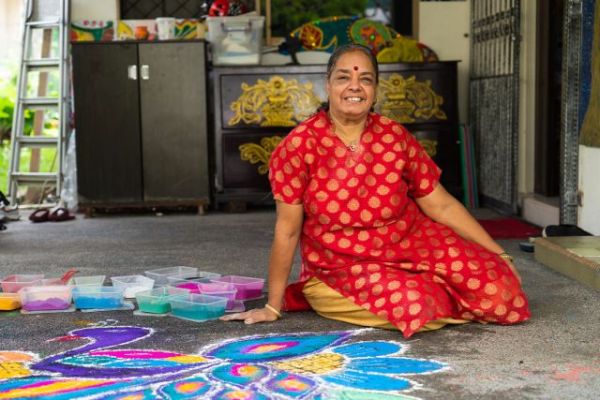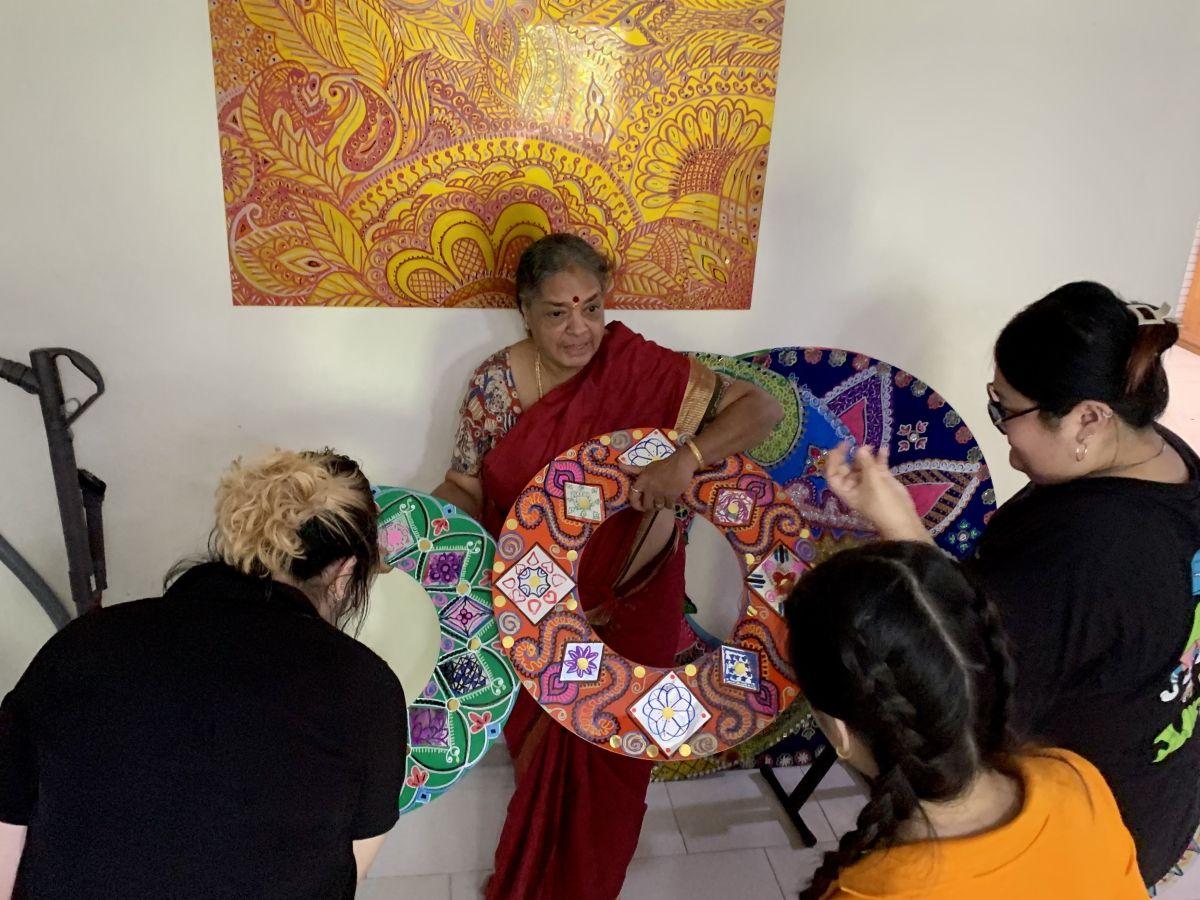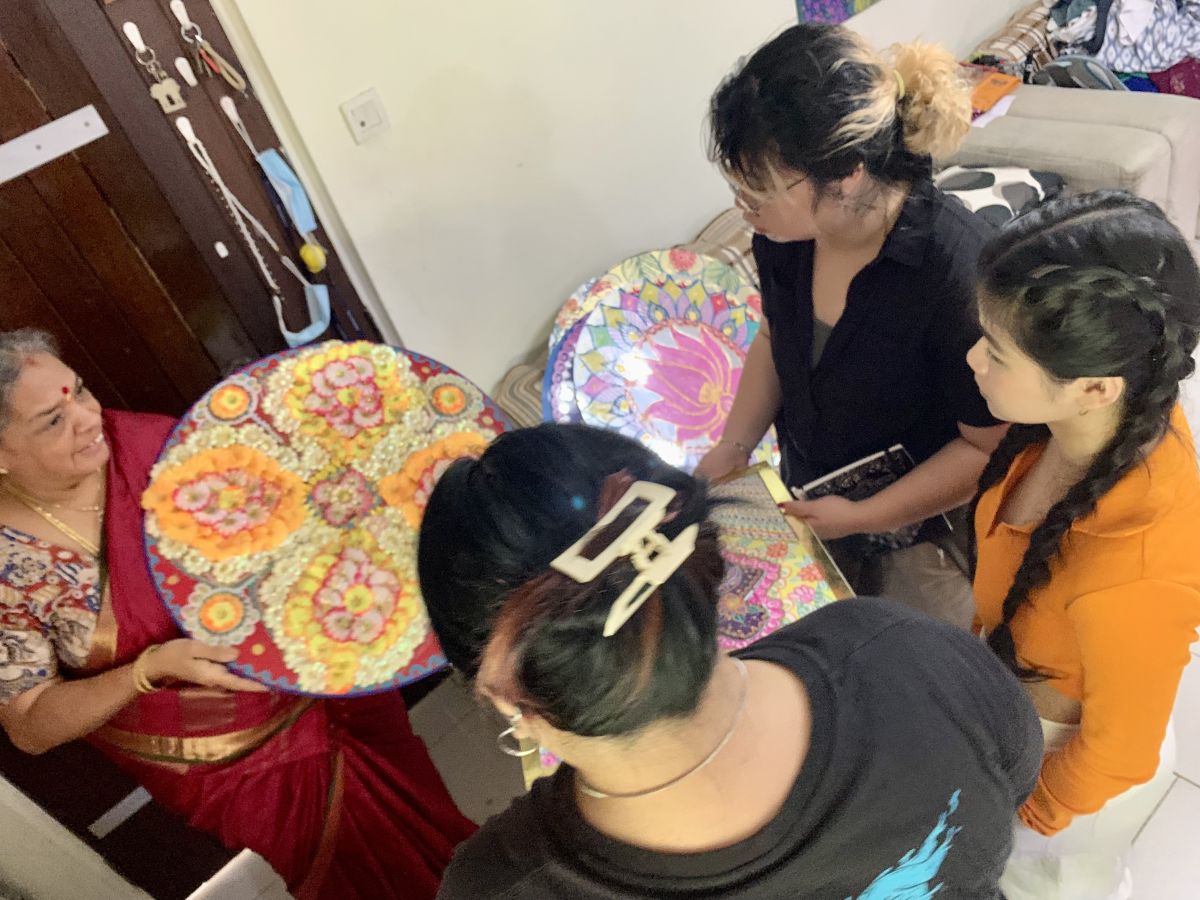
LASALLE x NHB : Tradition Craft (Rangoli) for GEN Z
Project Gallery

Ms Mohan and her works
Ms Mohan showing Rangoli made of a ring-like shaped acrylic.

Rangoli events in Singapore
Ms Mohan sharing images of the Rangoli events that she has done in Singapore on her phone.

Ms Mohan and her works
Ms Mohan sharing Rangoli made out of different recycled materials.

First meeting with Ms Mohan
Group photo with Ms Mohan and the team.
Context and problems
Context:
Craft X Design is a project initiated by National Heritage Board (NHB) to raise awareness of intangible cultural heritage (ICH) practises existent in Singapore by pairing a modern designer and a traditional craft expert to create modern contemporary products inspired by the following traditional crafts - Rangoli, Chinese Lantern, Ketupat Weaving, and Peranakan Beadwork and Embroidery.
The team will propose a prototype that will contribute to NHB's goal of re-imagining the chosen traditional craft, Rangoli, into innovative and modern products that will be appealing and relevant for youths to learn and appreciate traditional craft, and raise the profiles of local traditional craftsmanship, increasing access to new markets, networks, and designs for local traditional practitioners.
Problems:
NHB has curated a Craft X Design exhibition located at National Design Center, displaying the four re-imagined traditional crafts along with the craft’s history and the project’s process. However, after experiencing the exhibition, the team identified gaps that could be filled in order to better meet the NHB's goal for Craft X Design. Some of the key gaps include a missed opportunity for audiences to gain access and appreciation for Rangoli, as the exhibition is not promoted enough, is too static and lacks the experiences that youths seek - immersiveness, interactiveness, and tactility. The Rangoli corner was occupied with walls of words surrounding the display of the original craft materials and protected by a barrier that only allows attendees to view.
Furthermore, the exhibition appeared to be curated without a clear audience group in mind. The space planning, accessibility of the exhibition, and its lack of community outreach may be worth re-evaluating and re-curating to further appeal and pique the interest of the specific target audience group. As a result, the team felt that the Craft X Design exhibition appears to have limited access to the younger audiences.
Team Members and Roles
Koh Rui Qi
- Leader
- Client Liason Officer
- Project Coordinator
- Researcher
- Literature Reviews
- Craft Research: Rangoli
- Survey Creator
Koh Min Hui Ally
- Craft Practitioner Liason Officer
- Researcher
- Literature Review
- Audience and Audience Behaviours Research: Selected target audience, Youths, Generation Z
- Mock App UIUX (User Interface, User Experience) Designer
- Mock App Programmer
Carissa Huang
- Lead Researcher
- Artist Research
- Literature Reviews
- Project Strategist
- Flow of proposal document and presentation
Key Goals and Objectives
Key Goals
1. To promote the ICH of the traditional craft Rangoli by integrating aspects of traditional craft with a way of promoting wellness to youths (specifically the selected group, Generation Zs).
2. To increase access and achieve a better understanding and appreciation of traditional crafts such as Rangoli among Generation Zs that could potentially open doors to new markets for the craft to thrive in.
Key Objectives
1. Create a one-of-a-kind wellness-themed mood tracker app that integrates digital technology with a traditional art form.
2. To pique the interest, knowledge, and awareness of Rangoli among Generation Zs.
Project Timeline
Research and Conceptualisation Stage (27 January to 20 February 2023)
During this stage, the team was introduced to the problem statement, client and craft practitioner. The team researched into the craft of Rangoli and wellness in scoping the proposal. Throughout this process, the team was able to:
- Brainstorm
- Present first findings and conceptualisation on the first idea of ‘Movement of Colours’ to NHB
- Interviewed local Rangoli craft practitioner Ms Mohan
- Conducted Research into the subject areas of Rangoli, mental wellness, integrating art with technology, colour theory, and Gen Zs
- Re-evaluate the conceptualisation theme with supervisor
Further Research, Planning and Development (22 February to 10 April)
After further research, feedback and insights from all supporting personnel, the team then developed the final developed theme of ‘Rangoli: For the better wellness’ agreeing on the idea of using Rangoli to promote greater wellness of Generation Z audiences. This process includes:
- A follow-up official pitch to NHB on the second idea “Modern Remedy of Rangoli”
- A second interview with Ms Mohan for feedback on the second idea pitched
- Conducted further research based on the interview on topics like wellness, colours, and technology
- Adjustment of final idea theme - “Rangoli: For the better wellness”
- Creation and development of the proposed product
- Creation and sharing of the survey on the main proposal idea
- Creation of wireframes and mockups
Project Methodologies
- Interview with Ms Mohan
In order to gain a better insight and understanding of the art form, two interviews were conducted with Ms Mohan, a reputable Rangoli craft practitioner in Singapore.
The first interview aims to understand mainly the history, origins, and practice of Rangoli and to learn about Ms Mohan's artistic journey, the Rangoli events that she conducted for the general public, and the numerous small and large scale projects for and with the Rangoli community in the past two decades.
The second interview aims to gather her feedback on our pitched proposal, a mood tracker app integrating the craft and an exhibition - “Modern Remedy of Rangoli”. This interview provided us with more clarity and allowed us to scope it down to our final prototype idea.
- Literature Review
The team organised an interview with Ms Mohan first in view of her travel schedule, after which the rigorous literature review took place, Through this process of consulting the artist, it enabled the team to scale down to the specific topics that we could potentially explore for the final prototype. The team conducted literature reviews on technology’s benefit in improving mental wellness, various perspectives on the functions and usage of mood tracker apps, colour theory's role in wellness, and why art therapy improves wellness.
Our key search terms are “Art therapy”, “mental wellness”, “mood tracker”, “Integrating arts with technology”, “colour theory”, and “Generation Z”.
- Survey for potential users (Generation Zs)
A survey was administered to Generation Zs. The survey collected 82 respondents’ insights in gauging how active Generation Zs are in tracking their mental health and how appealing a mood tracker integrating traditional craft will be in motivating them to track their mental health. The survey findings were used to decide on the concept, theme, and UIUX functions of the app.
Project Research Insights
Interview findings
Ms Vijayalakshmi Mohan, a veteran Rangoli practitioner, was interviewed twice. The following insights were gathered.
First interview:
- Rangoli’s history, origin, practice, wellness benefits
- Singapore’s Rangoli community
Second interview, Ms Mohan’s thoughts on:
- Mood Tracker app inspired by Rangoli
- User interface and aesthetics
- Target audience: Generation Zs
- Attracted to immersive experiences
- Uses digital platforms for convenience
Literature review
From the literature reviews conducted, some of the insights that helped us frame our proposal ideas are:
- Benefits of Art Therapy and how it is related to mental wellness.
Art Therapy improves the overall wellness of a person, leaving a positive effect on one’s mental health.
- Benefits of integrating arts with technology
Combining both elements mitigates COVID-19’s negative impact and proved to enhance the quality of people's life.
- Mood Tracker findings and gaps
Mood Tracker users are attracted to the visuals and calendar features. Key gaps include the lack of tips and advice that could help them improve their mood.
- Colour theory and its positive impact on people
Colours are related to human psychological feelings and have biological and psychological effects. When used in harmony, colours can provide comfort and improve mental health.
- Generation Z mental health awareness
Gen-Zs are more open to discussing their mental health. They prioritise and recognise the importance of it more than previous generations.
Survey findings
With 82 responses collected, some key related findings are:
1. Tracking mental wellness
- 79% believed in the importance of mental wellness tracking.
2. Interest in Mood Tracker app
- 34.1% are Mood Tracker app users
- 30.5% would consider using
- 35.4% would not use it
3. Ranking of app features by importance (from highest to lowest):
- User-friendliness
- Daily journaling
- Visual appeal
- Tips and advice
- Virtual games
- Special Features (ASMR)
4. The attractiveness of traditional arts (Rangoli) with Mood Tracker app
- 82.9% would consider using it
- 17.1% not interested
Project Vision and Expected Outcomes
Project Vision:
The project vision is to help promote ICH practices in Singapore to youths, specifically Generation Zs by integrating art and technology. Through this promotion, new markets and opportunities for the development of traditional crafts will emerge, and youths will be more connected to their cultural heritage.
Expected Outcomes:
With the implementation of a mood tracker app integrated with Rangoli, we will be able to appeal, engage and help Generation Zs relate with the ICH of Rangoli that helps, support and keep track of their mental health. This might in turn inspire them to be more interested in learning more about not just Rangoli, but also other intangible cultural heritage existent in Singapore in the long run as well as consider an integration of traditional crafts into their daily lives.
Project Deliverables and Outputs
Deliverables:
- Propose a prototype to NHB that integrates with traditional art which will help in:
- Boosting the ICH practices in Singapore
- Creating new markets for the development of traditional crafts while targeting the youth (specifically Generation Zs)
- Improving mental wellness among youths (specifically Generation Zs)
- Conduct academic research on Generation Z audiences’ engagement and preferences to understand their interest in wellness and integrating traditional art with technology.
Output:
To develop a Mood Tracker app that incorporates Rangoli and its features. This app aims to provide wellness benefits such as tracking their mental wellness by introducing Generation Zs to the traditional craft of Rangoli and how its features combined with a mood tracker can bring such wellness benefits. Some of the key outputs to ensure that the app delivers its purpose:
- Wireframe design
- To ensure that the app interface and experience are user-friendly and easy to interact with
- Includes many features that are highly selected from the survey (user-friendliness, daily journaling, visual appeal, tips and advice, virtual games and special features) to provide a range of features that can suit users of different interests.
- Concept
- Includes a balance of wellness features and chosen traditional craft, Rangoli features
- Capturing the essence of the visuals with the intention of wellness
- Making the app accessible and able to be personalised
- Provides an Interactive and immersive experience



